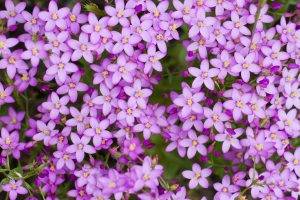
Little Thyme – Erythraea Centaurium L.
Thyme grass description:
Erythraea Centaurium L. Old or other known names: little centaury, centaury grass, centaury grass, centaury grass, centaury grass, centaury grass, centaury grass Gentianaceae – Gentianaceae The stems of the centaury are erect, four-edged, branched at the tip and, like the leaves, glabrous and glabrous along their entire length. Annual or biennial (needs cold action) (Th, TH). Leaves sessile, two opposite, oblong, narrow, ovate or leaf-shaped; upper leaves narrower and pointed. At the base of the stem, several leaves are densely clustered together, forming a leaf rosette. Flowers are dark pink – twisted-petalled, star-like – and form a many-flowered clustered inflorescence, a tent-like umbrella, which after flowering is quite rhombic-topped, the upper flowers all being of equal height. This is because the lower branches of the inflorescence are longer and the upper ones shorter. The centaury grows to about an arch or an arch and a half, or 15-30 cm. The stems are also up to 2 mm thick. It is a biennial plant. In the first year it produces a cluster of leaves with a stalk (a spike), in the second year it flowers, produces seeds and then withers. The centipede flowers from July to September. It has a cylindrical, two-headed capitate fruit with small seeds. Maturation can last until October.
Occurrence:
Thousand-grass likes sunny and also quite humid places. It grows best in sunny but not dry places. It is found on sunny, grassy hills, mown grasslands, meadows, wet grasslands, forest clearings, as well as on the edges of forests, in sparse thickets, alongside fields, on roadsides, in dry grasslands, and on hillsides up to 1400 m altitude. It occurs in both mountainous and lowland areas. It is particularly fond of sandy and loose calcareous soils. It is widespread in Europe as far north as Sweden, but also in the meadows of Central and West Asia, North America, North Africa, sandy places and open forests. In Hungary it is found everywhere but is rarer in the lowlands.Drug:
Centaurii herba: VIII Hungarian Pharmacopoeia: whole or chopped, dried above-ground shoots of flowering plant
Medicinal properties:
The above-ground part of centaury, picked in flower and dried, is used in pharmacy under the name Centaurii herba . This is because the upper part of the flowering plant contains a peculiar bitter substance, for which it is used as a household remedy. It is mostly used as a stomachic and diaphoretic tea. It is also added to wine and brandy to make a stomach-strengthening drink. Its name derives from the fact that in ancient times it was highly valued for its healing properties. Thyme grown in the woods tends to be long-stemmed and larger-flowered, while that grown in the fields is shorter and not as well developed. Both forest and field yarrow are used in the pharmacy, but forest yarrow is more valuable and is paid more. It is a constituent of many kinds of tea mixtures, including species amaricantes, and is also an important ingredient in a preparation called tinctura amara (1906).
Forms of use:
Formation of bitter taste, flavouring, stomachic, appetite stimulant, food flavouring, traditionally used in anorexia and indigestion.
Oral administration for adults:
– Herb: 2-4 g as a tea in 150 ml of water, three times daily. – Liquid extract: 2-4 ml (1 : 1 in 25% alcohol) three times a day.
Contraindications:
For gastrointestinal ulcers, pregnancy and breastfeeding!
In vitro and animal experiments:
– Aqueous extract, in rat – anti-inflammatory – Aqueous extract in rat – antipyretic (phenolic acid effect, not suitable for prevention) – in mouse models of liver failure – tumour inhibitor – central nervous system sedative – anti-ulcer Canephron tablets: diuretic, antispasmodic, anti-inflammatory, antimicrobial.
Active ingredients:
– Secoiridoid glycosides 2%, give the plant its characteristic bitter taste. – Xanthones – Phenolic acids – Flavonoids: 0.4% – Erythrocentaurin, – Valeric acid – Resin
Collection and harvesting:
Thyme should be collected during the flowering period (July-August). It is best harvested in the July snow, as it is only good while the stems and leaves are still fresh and lush green and the flowers are bright pink; once they start to yellow, they are worthless and useless. Cut the whole plant 40 cm above the ground when the leaves are fresh green and the flowers are bright pink. In areas free from pollution, in full bloom, in sunny weather. Cut off the base of the 100-flowered grass at the base and remove the roots. It is then tied in quarter or half-kilo bundles and strung up on twine in the attic or other shady, airy place, like tobacco, because only then does it get all the air and dry well (in a thin layer in an immediate, natural, shady, airy place). During drying it will lose a quarter of its weight, so that 1 kilo of fresh grass becomes 1/4 kilo of dry centiped grass. It takes 4-6 days to dry. Since the tips, leaves and stems contain most of the medicinal substances, the dried grass should be packed in such a way that the finest particles do not break off during transport. It is therefore better to pack it in a crate rather than a bag. Source: Dr Ferenc Darvas and Dr Gyula Magyary-Kossa,Domestic herbs, their production, marketing, effects and medicinal uses Béla Páter, Wild medicinal plants, their production, use, distribution, and marketing

